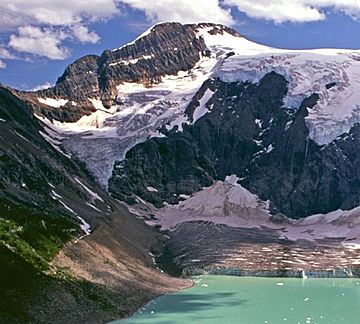Commander Mountain facts for kids
Quick facts for kids Commander Mountain |
|
|---|---|

Commander Mountain, northwest aspect
|
|
| Highest point | |
| Elevation | 3,371 m (11,060 ft) |
| Prominence | 91 m (299 ft) |
| Parent peak | Jumbo Mountain (3437 m) |
| Listing | Mountains of British Columbia |
| Geography | |
| Location | British Columbia, Canada |
| Parent range | Purcell Mountains |
| Topo map | NTS 82K/07 |
| Climbing | |
| First ascent | 1915 |
| Easiest route | North ridge |
Commander Mountain is a 3,371-metre (11,060 ft) glaciated mountain summit located 42 km (26 mi) west-southwest of Invermere in the Purcell Mountains of southeast British Columbia, Canada. It is the seventh-highest mountain in the Purcells. The nearest higher peak is Jumbo Mountain, 2 km (1.2 mi) to the south, and The Lieutenants is set 2.12 km (1.32 mi) to the west. The first ascent of Commander Mountain was made August 4, 1915, by A.H. & E.L. MacCarthy, M. & W.E. Stone, B. Shultz, and Conrad Kain via the north ridge. The peak was named in 1915 by Winthrop E. Stone, member of the first ascent party.
The mountain's name was officially adopted July 17, 1962, when approved by the Geographical Names Board of Canada. Based on the Köppen climate classification, Commander Mountain is located in a subarctic climate zone with cold, snowy winters, and mild summers. Temperatures can drop below −20 °C with wind chill factors below −30 °C. This climate supports the Jumbo Glacier on its west slope, and Commander Glacier on the east slope. Precipitation runoff from the mountain and meltwater from its surrounding glaciers drains into Horsethief Creek which is a tributary of the Columbia River.
Climbing Routes
Established climbing routes on Commander Mountain:



